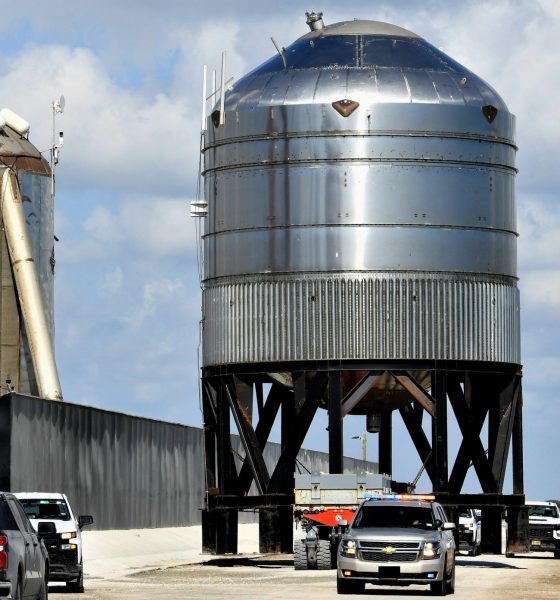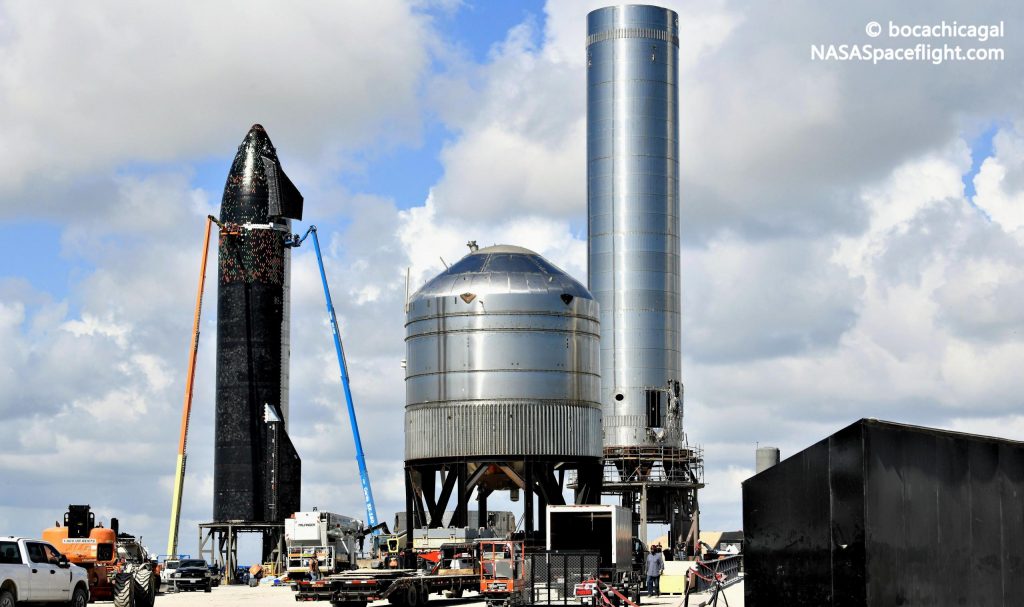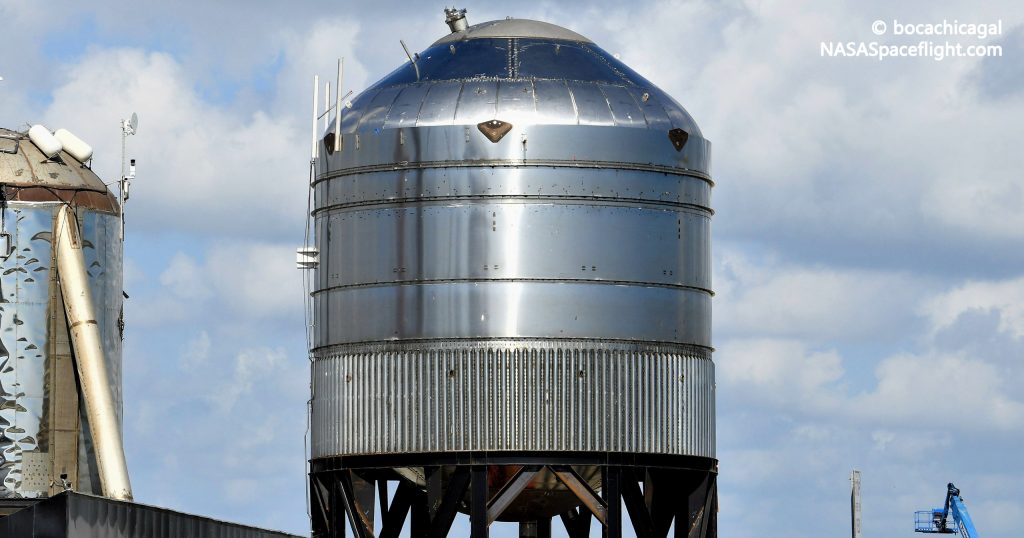

News
SpaceX to put custom Starship propellant storage tanks through first trial
In the latest twist in the saga of SpaceX’s custom-built Starship launch pad propellant storage tanks, the company appears to have retroactively decided to build small prototype meant solely for testing.
Known as a ‘test tank,’ the relatively small steel structure was fairly rapidly assembled from parts of an older Ground Support Equipment (GSE) tank scrapped in July over the last week or so. SpaceX completed the first Starship-derived propellant storage tank in April 2021 and rapidly rolled that tank (GSE1) and a second (GSE2) from the build site to the orbital launch pad just a few weeks apart. Less than a month after that, SpaceX also completed GSE tank #3, though things seemingly devolved into chaos immediately thereafter.
Only three months later would GSE3 finally be transported to – and installed on a concrete mount at – Starship’s first orbital launch site, and only after a number of structural modifications and in the footsteps of GSE tanks #5 and #6. Little is known about why SpaceX’s custom GSE tank production faltered so soon after it began, why none of the five Starship-sized tanks installed at the orbital pad have been fully plumbed or subjected to any kind of testing, or why structural modifications were seemingly required after the fact. However, it’s safe to say that SpaceX’s brand new GSE ‘test tank’ is now at the center of the mystery.

Thankfully, at minimum, the rapid appearance of SpaceX’s first GSE test tank returns some level of familiarity to the brief but chaotic history of Starship’s orbital launch pad propellant tanks. Test tanks are nothing new and have been an integral part of Starship development since Test Tank 1 first headed to SpaceX’s suborbital launch (and test) facilities in January 2020. In the 20 months since, SpaceX has built and tested seven small test tanks, several of which didn’t survive.
Whether intentionally destroyed or not, each test tank explicitly helped SpaceX qualify new manufacturing techniques, different materials, and different skin thickness and generally gather data more quickly and cheaply than full-scale prototypes would allow. Most recently, for example, SpaceX seemingly successfully tested a Super Heavy booster test tank, subjecting the prototype to cryogenic liquid nitrogen and using hydraulic rams to simulate the thrust of nine Raptor engines on an unproven disk-like thrust structure.
Now, almost as if SpaceX snapped out of a trance and remembered the utility of test tanks, the company has assembled a subscale GSE prototype presumably meant to verify that its custom-built propellant storage tanks can handle a set of conditions significantly different from the Starships they’re derived from. In this case, that GSE tank was quite literally built from scrapped sections of GSE tank #4. In fact, the top half (forward dome section) was quite literally cut off of GSE4 after the tank was scrapped last month for unknown reasons.
Over the last several months, while GSE tank production and installation took an unexpected hiatus, SpaceX workers slowly but surely welded steel rings (stiffeners) to the exterior of GSE1, GSE2, and GSE3. When GSE5 and GSE6 eventually headed to the pad, they left with those stiffeners already installed, implying that whatever tripped SpaceX up was likely structural. The GSE4 test tank also includes external stiffeners along each circumferential weld (where rings were stacked or domes joined).


At the same time as SpaceX was (or wasn’t, for several months) building its own GSE tanks, contractors normally tasked with assembling water towers and storage tanks in situ built eight massive 12m (~40 ft) wide tanks of their own. Deemed “cryo shells,” much like their name suggests, those tanks are meant to fully enclose SpaceX’s GSE tanks. SpaceX will use those shells to insulate their thin, single-walled steel propellant tanks, thus keeping their cryogenic contents cryogenic for as long as possible. How they’ll be insulated is unclear, though.
Based on the seemingly retroactive decision to strengthen the exterior of those GSE tanks, the general consensus as of late is that SpaceX wants to pull at least a partial vacuum in the gap between shell and tank. It’s also possible that SpaceX will do the opposite and pressurize that gap (as much as possible) with an insulative gas like nitrogen. Extra confusion comes from the fact that Starship tanks are technically designed to support a literal spacecraft (operating in a near-total vacuum) without the need for external stiffeners.
Additionally, it’s fairly clear that SpaceX hasn’t built a custom subscale cryoshell or concrete installation pad for its GSE4 test tank, meaning that it will really only be useful for testing some of the loads operational GSE tanks will experience inside their sleeves. Additionally, given that SpaceX has already completed six of the orbital pad’s seven GSE tanks and all seven of their cryosleeves, the discovery of any significant issues during GSE4 testing could easily trigger months of rework and delays. With any luck, though, GSE4 will sail through an imminent test campaign, clearing the way for SpaceX to finish plumbing, sleeving, and activating Starship’s first orbital launch site tank farm.

Elon Musk
Elon Musk’s X will start using a Tesla-like software update strategy
The initiative seems designed to accelerate updates to the social media platform, while maintaining maximum transparency.

Elon Musk’s social media platform X will adopt a Tesla-esque approach to software updates for its algorithm.
The initiative seems designed to accelerate updates to the social media platform, while maintaining maximum transparency.
X’s updates to its updates
As per Musk in a post on X, the social media company will be making a new algorithm to determine what organic and advertising posts are recommended to users. These updates would then be repeated every four weeks.
“We will make the new 𝕏 algorithm, including all code used to determine what organic and advertising posts are recommended to users, open source in 7 days. This will be repeated every 4 weeks, with comprehensive developer notes, to help you understand what changed,” Musk wrote in his post.
The initiative somewhat mirrors Tesla’s over-the-air update model, where vehicle software is regularly refined and pushed to users with detailed release notes. This should allow users to better understand the details of X’s every update and foster a healthy feedback loop for the social media platform.
xAI and X
X, formerly Twitter, has been acquired by Elon Musk’s artificial intelligence startup, xAI last year. Since then, xAI has seen a rapid rise in valuation. Following the company’s the company’s upsized $20 billion Series E funding round, estimates now suggest that xAI is worth tens about $230 to $235 billion. That’s several times larger than Tesla when Elon Musk received his controversial 2018 CEO Performance Award.
As per xAI, the Series E funding round attracted a diverse group of investors, including Valor Equity Partners, Stepstone Group, Fidelity Management & Research Company, Qatar Investment Authority, MGX, and Baron Capital Group, among others. Strategic partners NVIDIA and Cisco Investments also continued support for building the world’s largest GPU clusters.
News
Tesla FSD Supervised wins MotorTrend’s Best Driver Assistance Award
The decision marks a notable reversal for the publication from prior years, with judges citing major real-world improvements that pushed Tesla’s latest FSD software ahead of every competing ADAS system.

Tesla’s Full Self-Driving (Supervised) system has been named the best driver-assistance technology on the market, earning top honors at the 2026 MotorTrend Best Tech Awards.
The decision marks a notable reversal for the publication from prior years, with judges citing major real-world improvements that pushed Tesla’s latest FSD software ahead of every competing ADAS system. And it wasn’t even close.
MotorTrend reverses course
MotorTrend awarded Tesla FSD (Supervised) its 2026 Best Tech Driver Assistance title after extensive testing of the latest v14 software. The publication acknowledged that it had previously criticized earlier versions of FSD for erratic behavior and near-miss incidents, ultimately favoring rivals such as GM’s Super Cruise in earlier evaluations.
According to MotorTrend, the newest iteration of FSD resolved many of those shortcomings. Testers said v14 showed far smoother behavior in complex urban scenarios, including unprotected left turns, traffic circles, emergency vehicles, and dense city streets. While the system still requires constant driver supervision, judges concluded that no other advanced driver-assistance system currently matches its breadth of capability.
Unlike rival systems that rely on combinations of cameras, radar, lidar, and mapped highways, Tesla’s FSD operates using a camera-only approach and is capable of driving on city streets, rural roads, and freeways. MotorTrend stated that pure utility, the ability to handle nearly all road types, ultimately separated FSD from competitors like Ford BlueCruise, GM Super Cruise, and BMW’s Highway Assistant.
High cost and high capability
MotorTrend also addressed FSD’s pricing, which remains significantly higher than rival systems. Tesla currently charges $8,000 for a one-time purchase or $99 per month for a subscription, compared with far lower upfront and subscription costs from other automakers. The publication noted that the premium is justified given FSD’s unmatched scope and continuous software evolution.
Safety remained a central focus of the evaluation. While testers reported collision-free operation over thousands of miles, they noted ongoing concerns around FSD’s configurable driving modes, including options that allow aggressive driving and speeds beyond posted limits. MotorTrend emphasized that, like all Level 2 systems, FSD still depends on a fully attentive human driver at all times.
Despite those caveats, the publication concluded that Tesla’s rapid software progress fundamentally reshaped the competitive landscape. For drivers seeking the most capable hands-on driver-assistance system available today, MotorTrend concluded Tesla FSD (Supervised) now stands alone at the top.
News
Elon Musk’s Grokipedia surges to 5.6M articles, almost 79% of English Wikipedia
The explosive growth marks a major milestone for the AI-powered online encyclopedia, which was launched by Elon Musk’s xAI just months ago.

Elon Musk’s Grokipedia has grown to an impressive 5,615,201 articles as of today, closing in on 79% of the English Wikipedia’s current total of 7,119,376 articles.
The explosive growth marks a major milestone for the AI-powered online encyclopedia, which was launched by Elon Musk’s xAI just months ago. Needless to say, it would only be a matter of time before Grokipedia exceeds English Wikipedia in sheer volume.
Grokipedia’s rapid growth
xAI’s vision for Grokipedia emphasizes neutrality, while Grok’s reasoning capabilities allow for fast drafting and fact-checking. When Elon Musk announced the initiative in late September 2025, he noted that Grokipedia would be an improvement to Wikipedia because it would be designed to avoid bias.
At the time, Musk noted that Grokipedia “is a necessary step towards the xAI goal of understanding the Universe.”
Grokipedia was launched in late October, and while xAI was careful to list it only as Version 0.1 at the time, the online encyclopedia immediately earned praise. Wikipedia co-founder Larry Sanger highlighted the project’s innovative approach, noting how it leverages AI to fill knowledge gaps and enable rapid updates. Netizens also observed how Grokipedia tends to present articles in a more objective manner compared to Wikipedia, which is edited by humans.
Elon Musk’s ambitious plans
With 5,615,201 total articles, Grokipedia has now grown to almost 79% of English Wikipedia’s article base. This is incredibly quick, though Grokipedia remains text-only for now. xAI, for its part, has now updated the online encyclopedia’s iteration to v0.2.
Elon Musk has shared bold ideas for Grokipedia, including sending a record of the entire knowledge base to space as part of xAI’s mission to preserve and expand human understanding. At some point, Musk stated that Grokipedia will be renamed to Encyclopedia Galactica, and it will be sent to the cosmos.
“When Grokipedia is good enough (long way to go), we will change the name to Encyclopedia Galactica. It will be an open source distillation of all knowledge, including audio, images and video. Join xAI to help build the sci-fi version of the Library of Alexandria!” Musk wrote, adding in a later post that “Copies will be etched in stone and sent to the Moon, Mars and beyond. This time, it will not be lost.”








